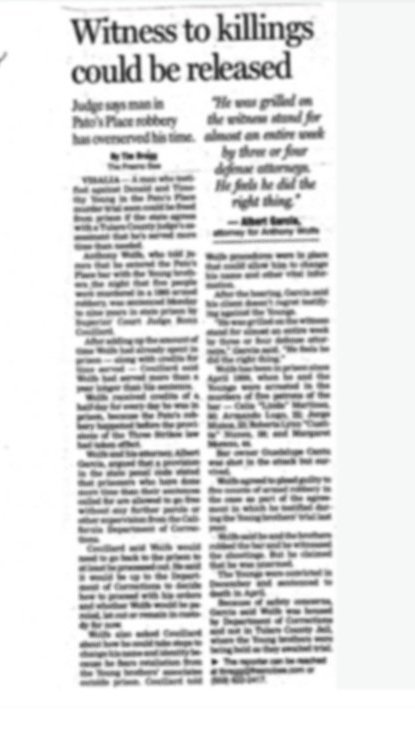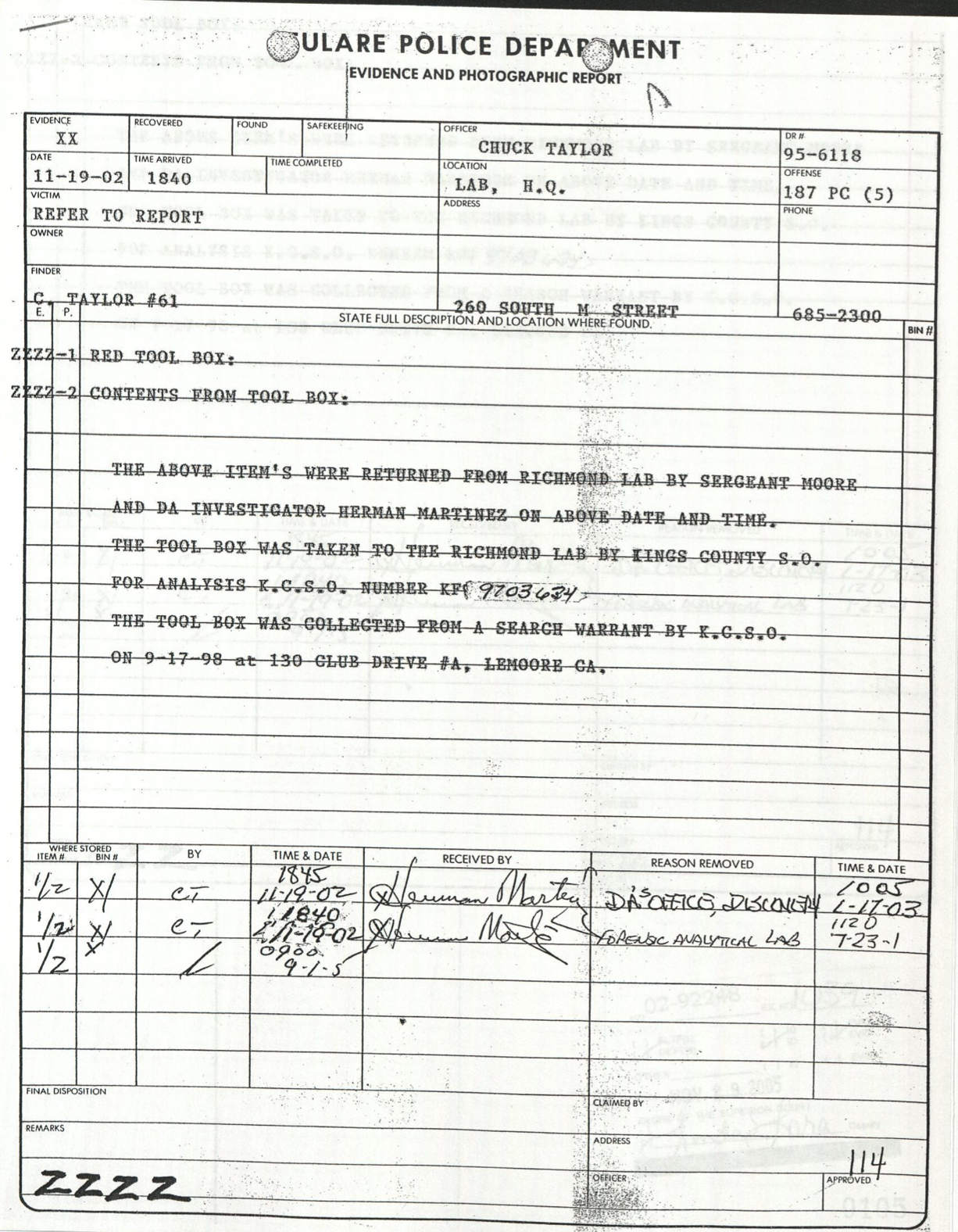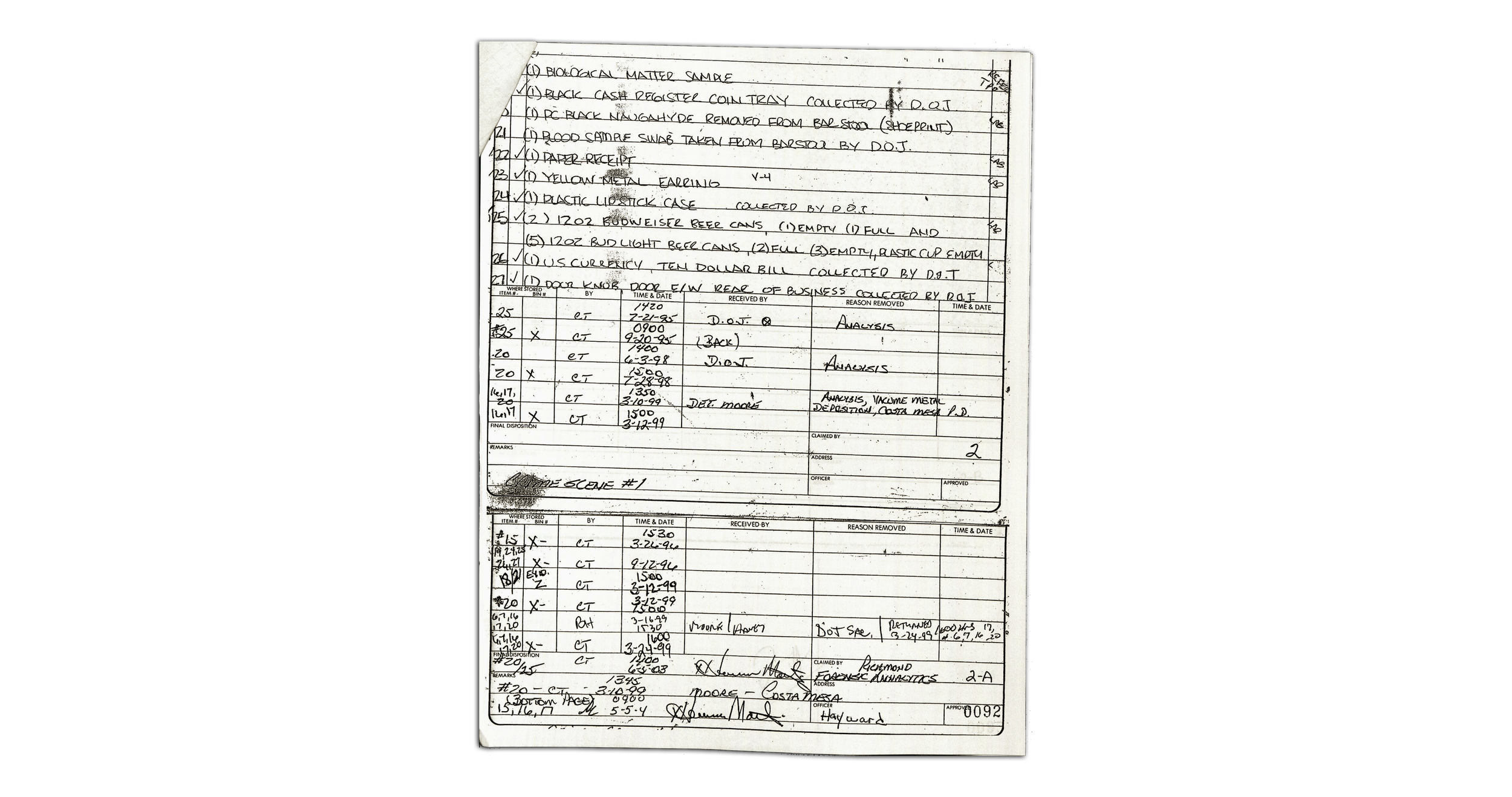case overview
See the factual timeline of the case.
There are serious problems with tim’s conviction.
Tulare Police mishandled evidence, ignored exculpatory witnesses, and disregarded evidence of third party culpability, All to frame a black man for murder.

Evidence mishandling, chain of custody issues, and brady violations
“It is shocking to me that what is happening here is they are attempting to kill these two men. That’s the end result, that’s what their goal is. And there is just no problem with just dumping hundreds of pages of discovery on the defense last minute, withholding certain documents. It’s staggering to me. And to not provide counsel enough time to review them as they relate to each other is a travesty of justice.
”
A month before the end of trial, the defense discovered that the prosecution had not turned over all the case evidence. This issue was revealed when the prosecutor accidentally referenced an updated evidence log that the defense did not have. When the evidence logs were finally handed over, the defense realized that key dates and other information had been changed from previous copies they were given.
The official evidence logs from the tulare property room were covered in white-out, with key dates changed and important information altered.
Most importantly, the records keeper testified at trial that the evidence logs did not show any indication of where a shoe found along the escape route was. This is the only piece of evidence that had any of Tim’s DNA on it.
The dates showing when evidence was in testing or in police custody were changed. There were periods of multiple years during which key pieces of evidence were completely unaccounted for or in the hands of the police while they were collecting reference samples from tim.
“I have discussed with the DA, Herman Martinez, on different occasions that we did not document as well as we should have or could have some of the movement of evidence.”
scans of the evidence logs with white out changing the dates.
“We got about midway through the trial, the Tulare Police Department had the…now don’t tell anybody else this, be careful with my quote here, they had the most God-awful evidence room.”
In 2016, an audit conducted on the Tulare Evidence Room was released, revealing a lack of protection of evidence and a lack of professionalism from the technicians who ran it.
Later in 2016, TPD Technician Gary Coffman, one of the evidence technicians who processed evidence throughout the case’s investigation, was arrested for stealing from the evidence room, tampering with evidence, embezzlement, drug and weapons possession, and human trafficking.
The evidence in the Pato’s Place investigation was shaky against Tim to begin with – DNA that could have been linked to Tim was only found in a small complex mixture sample on a tennis shoe recovered from the crime’s supposed escape route.
Since chain of custody was broken and improperly maintained, the evidence could have been contaminated or tampered with and should never have been admissible in trial.
IMPROPERLY MAINTAINED EVIDENCE was USED TO SEND TWO MEN TO DEATH ROW.

THIRD PARTY CULPABILITY
4 people were named in the investigation as suspects, 2 by confession and 2 by a woman named Virginia Walker.
Virginia Walker came to the courthouse at the end of the sentencing phase of Tim’s trial because the police and the prosecutor had refused to respond to her earlier attempts to tell them who was responsible for the murders.
WHY DID TULARE POLICE IGNORE A WOMAN WILLING TO PUT HER LIFE ON THE LINE TO SAVE TIM’S?
HERE’S WHAT WE KNOW.
A MAN CONFESSED TO POLICE about his involvement.
A man by the name Frost confessed to the police about his involvement in the murders, saying that he was ‘doing something’ for Angulo, the business partner of the bartender who was shot.
Many suspect that Angulo was the intended target of the shooting, because of his involvement with organized crime and drug use and distribution.
A WOMAN CONFESSED TO POLICE after being implicated.
A woman named Contreras was implicated by Frost. She confessed involvement in the crime, but during her testimony she later recanted her statement.
Witnesses and others who have testified stated that a woman drove the car in the crime.
WALKER implicated a different man by the name nicks.
Nicks told Walker about a man named Edwards, who confessed to Walker.
Walker came to the courthouse on the last day of the trial, desperate to talk to the defense counsel. A member of the defense team spoke with her. Read her statement here.
Nicks told Walker of Edwards, who confessed to her. Edwards forced Walker to collect the weapons used in the crime from his home so that they would not be found by law enforcement.
Nicks and Edwards told Walker that a woman was involved in the murders with them.

unreliable witnesses
There were two key witnesses in Tim’s trial, but both were unreliable and had bias, motive, and reason to lie on the stand.
Actual transcription from the testimony of Anthony Wolfe as he is cross-examined by a member of the defense.
Defense is the Q lines, Wolfe is the A lines.
-
Anthony Wolfe testified that he was the third gunman at the Pato’s Place homicides along with Tim and Donald Young. Anthony Wolfe didn’t come forward until 1997, and Tim wasn’t even a person of interest in the investigation until Wolfe started talking to the police.
Wolfe’s story constantly changed. He could never keep track of who entered the bar first, who shot first, and if he got a change of clothes in a house or a car. One day he said he walked in the bar first, the next day he walked in third. One day he suddenly remembered he might have driven Tim to a doctor’s appointment on the day of the murders. One day he leaves out a detail about the murder scene that he had been sure of the day before.
Wolfe’s stories were inconsistent, he had motive to lie, and the only two pieces of evidence he knew that weren’t public information were that there was a glass of amber-colored liquid sitting on the bar the night of the murders and that one of the murderers had jumped over the bar.
Wolfe met with police and prosecutors for hours and hours leading up to the trial as they helped him craft his story, but to this day, no physical evidence was ever found that tied Wolfe to the crime scene.
At trial when, after a ten minute recess, Wolfe realized that he had changed his story regarding which victim was killed first, he informed the court that he wanted to amend his most recent statement.
-
Guadalupe Cantu was the surviving witness to the crime, but his description of the shooters changed during the course of the investigation.
In his first interview with police, Cantu said the shooters were 5’8”, skinny Hispanic men. Later, Cantu said they may have been Black. The below graphic models the difference in size between a 5’8” skinny man and a 6’3” 320 pound man, which was Tim’s size at the time of the murders.
Even the police were skeptical of Cantu’s reliability. They were so unsure of Cantu's reliability that they released his nephew from jail, set up a meeting between him and Cantu and made him wear a wire so they could find out what Cantu really saw that night.
Cantu told his nephew that he would not tell the police anything and, when it came time for retribution, they could be a team. Cantu also stated that one of the victim’s might have known the murderers.

The snitch testimony
Anthony Wolfe sold Tim’s freedom. All he had to do was give a good story.
Kings County police officer Benny Velo asked Wolfe for information on the Young family. He told him there was good money for those in the area who snitched, and officers were known to be hostile to Black residents in Kings County and Tulare County.
Years later, facing a heavy sentencing for forgery, Wolfe begged enforcement to spare him. He offered a narrative where he claimed to have information on Pato’s and the Young brothers.
Wolfe knew Tim. Wolfe was in a relationship with Tim’s family member, and she had asked that Tim help Wolfe out. Wolfe was homeless, just released from prison, and had nowhere to go in 1997.
Tim gave Wolfe money, clothes, and a car.
Wolfe in turn gave Tim a death sentence.
Wolfe said that he spent all day with Tim.
But Tim has multiple alibis through witness statements, doctor’s notes and visits, and workplace paperwork that counter Wolfe’s story and the story of the other key witnesses.
Below is a map.
On the left is Tim’s day, proven by a surplus of alibis and witnesses.
On the right is Wolfe’s false narrative. Use the slide bar in the middle to see the two maps.
“Almost a decade ago, Northwestern University Law School issued a report finding that over 45% of all wrongful capital convictions, that is all the innocent people who ended up on death row about whom we know, were there because of a lying compensated informant.”
After he testified against Tim and Donald Young, Wolfe walked free.

the jury
Tulare County has a high hispanic population, and a small black population.
Tim and other black Tulare residents were often harassed by the police due to their race. those in power often tried to turn marginalized communities against each other.
“People often try to fragment or alienate people of color. But this is a unified front.” -Timothy James Young
Listen to a childhood friend of tim’s explain his experience in tulare as a black man:
What is the demographic makeup of the people called to jury in tim’s case?
How many black jurors made it to trial?
This was no coincidence.
While being questioned by the jury box, the prosecutor in Tim’s case asserted unsubstantiated claims about a Black juror.
After the judge ruled in favor of the defense’s motions that the strike was discriminatory, the prosecutor made a last-ditch effort to have the Black woman removed from jury pool. The prosecutor then gave a story of conflict due to the woman working in a clerical position in the District Attorney’s office and having previously had a workplace dispute with the prosecutor.
Despite the juror having no memory of this event, the prosecutor admitting her memory was “shaky,” and no formal complaints ever filed, the judge accepted the prosecution’s strike – removing the only Black person from serving on the jury.
The Supreme Court has upheld rulings that removing jury members from a panel based solely on their race being the same as the defendant is unconstitutional and a direct violation of the 6th and 14th amendment.
there’s more.
Tim has been incarcerated for 22 years and still maintains his innocence.
Tim and Lauren, a student at Georgetown University working on his exoneration.
he’s fought to prove it too.
Tim’s conviction relied solely on the false testimony of a snitch and faulty DNA evidence that never should have been admitted at trial. However, Anthony Wolfe’s plea deal, witness coercion, and the prosecution withholding key exculpatory evidence show the lengths officials were willing to go to conceal the truth.
Tim is the victim of a deeply racist judicial system that values convictions and closure over fairness and due process. Tim’s court-appointed attorneys have egregiously failed him every step of the way.















